Keyword optimization is a fundamental SEO technique that can improve your website’s visibility in search results and attract more visitors.
In this keyword optimization guide, we will share the knowledge, techniques, and tips required to excel in this aspect of SEO. Use this guide to outshine your competitors and deliver exceptional results for your clients.
TL;DR
- Keyword research is the foundation of keyword optimization. Start with identifying the right keywords.
- Once you have identified your target keywords, you can use them throughout your website content, including your titles, headings, internal linking, and images. Analyze your pages and strategically place your selected keywords.
- Use keywords naturally and avoid keyword stuffing. Your content should be readable and informative, not just a list of keywords.
- Use SEO tools to assist with keyword research and content analysis.
- Monitor your results and make adjustments to your strategy as needed.
What is keyword optimization
Keyword optimization is the process of researching, selecting, and using relevant keywords to improve your website’s visibility and attract targeted organic traffic. By aligning your website with the keywords that your target audience is searching for, you can increase your chances of appearing prominently in search engine results pages (SERPs).
Keyword optimization is also important for pay-per-click (PPC) advertising. It allows you to display ads to target audiences and spend your marketing budget efficiently. This ensures no time is wasted on irrelevant queries.
Why keyword optimization is important
Incorporating relevant keywords into your website can have many benefits, including:
- Enhanced search engine rankings: Search engines can more clearly understand the content and context of your website when they encounter relevant keywords on it. This can lead to higher rankings in SERPs and improved visibility.
- Increased organic traffic: By targeting the right keywords and ranking higher, you can attract more visitors to your website. Google’s top three search results get 54.4% of all organic traffic.
- Improved user engagement: When the content on your site is relevant to the keywords that users are searching for, they are more likely to stay and read more. This can lead to higher engagement metrics, such as time-on-page and bounce rate.
- Higher conversion rates: Using relevant keywords can help you target high-value traffic that is more likely to convert. Targeting bottom-of-the-funnel keywords can help you attract users who are already interested in your products or services. This means that optimizing for keywords can bring you more leads, sales, and other desired outcomes.
Given these advantages, keyword optimization is critical to any SEO strategy. It deserves your full attention and effort.
Now, let’s move on to the nitty-gritty.
How to conduct keyword optimization
Let’s go over the keyword optimization process step by step. In this section, you’ll learn how to find the right keywords, audit your pages, and optimize them for search engines.
Finding the right keywords
Keyword research is the first step in the keyword optimization process. It involves identifying keywords that resonate with your target audience (and their search intent). This helps you craft content that meets their needs and ranks high in search engine results.
There are many tools available to help you identify the most relevant keywords for SEO. Strategic keyword research can be rather complex and combines different tools and approaches.
Now, let’s shift our focus back to finding the right keywords using SE Ranking.
Start by brainstorming 1-3 seed keywords. These are general terms or phrases that are directly related to your business, products, or services. They correspond to your website’s goals and objectives. For example, if you sell shoes, some seed keywords might include “shoes”, “sneakers”, “athletic shoes”, “running shoes”, etc.
After you have settled on your seed keywords, begin filling in your keyword list. You can use the Keyword Ideas Generator tool in SE Ranking to get thousands of suggestions based on your seed terms. Just click the View Detailed Report button to immediately see them.

Keyword suggestions are separated into three categories:
- Similar keywords: These keywords feature your seed keyword and various modifiers that specify and narrow down the intent behind the query. For example, if you start your search with “insomnia treatment”, you’ll get suggestions such as “chronic insomnia treatment” and “insomnia home treatment.”
- Related keywords: These may not resemble your seed keyword at all, but they are often synonymous with your seed keyword. You can also use them to introduce subtopics on your site. For example, the “insomnia treatment” seed keyword is related to the following queries: “symptoms of insomnia”, “sleep medication”, or “meds for sleep.”
- Questions: These include questions related to your seed keywords, for example, “what is the treatment for insomnia.” Queries like these can help you cover the topic from different angles.

To choose the right keywords, you can rely on comprehensive data on each one, including:
- Keyword difficulty score: This score tells you how difficult it will be to rank in the top 10 results for this keyword. The score can vary from 0 to 100, with 100 signifying the maximum difficulty.
- Search volume: This is the average number of monthly searches for this search query.
- Cost per click: This is the average amount advertisers pay for a single click in a PPC Google Ads campaign for this keyword.
- Search intent: Indicates the likely purpose behind a user’s query. It is categorized as informational, commercial, navigational, transactional, or local.
- Seasonality trends: A small chart that shows the change in the monthly search volume for this keyword over the past year.
- SERP Features: Highlights special boxes and additional elements like featured snippets, video boxes, etc. that appear in search results for the analyzed keyword.
- Competition: This metric reveals the number of advertisers competing for a keyword relative to all keywords across Google. It’s categorized as low (0-0.3), average (0.3-0.7), and high (0.7-1) competition.
You can apply the filters below to immediately get more relevant results: specify minimum search volume, maximum keyword difficulty, your preferred search intent, etc. You can also filter results to see long-tail keywords only. Long-tail keywords often have less competition and can be highly targeted to specific user intents.
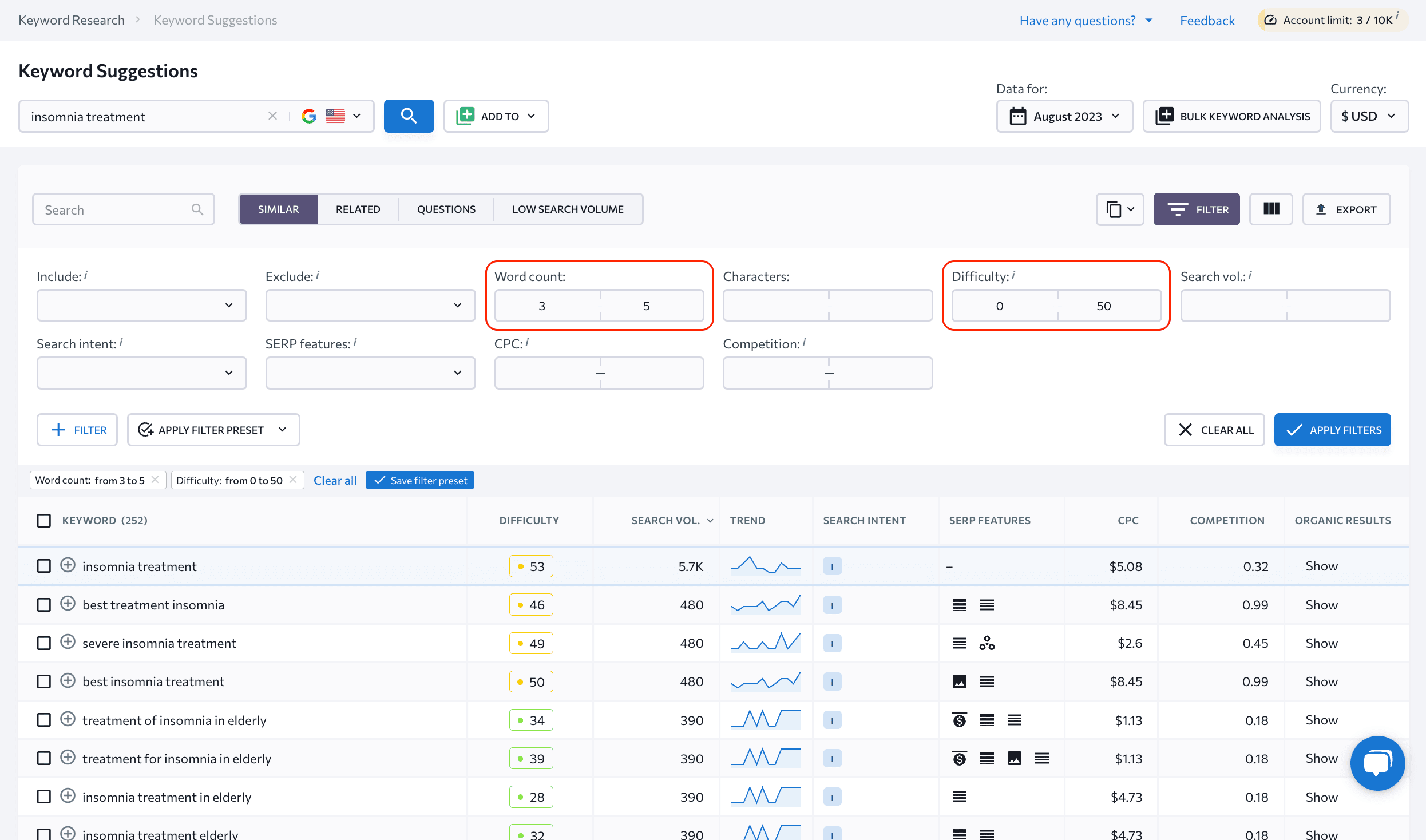
Another useful way to choose the right keywords is through the list of top-ranking pages for this query. You can access it by clicking the Show button.
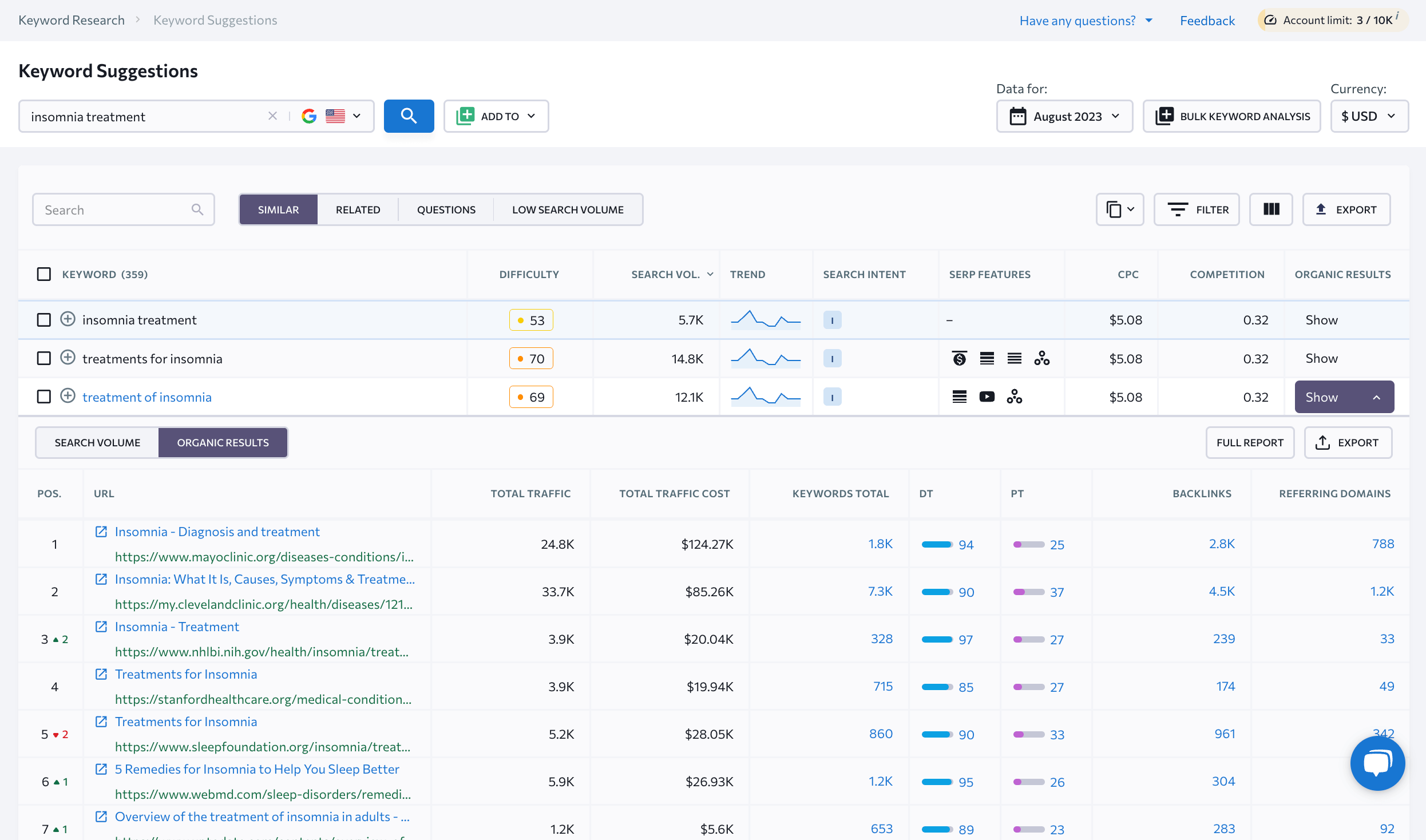
You will see each page’s estimated traffic volume, monthly traffic cost, the total number of keywords it ranks for, Domain Trust and Page Trust score, and the number of backlinks and referring domains. These metrics should show you how much traffic you could drive to your site by covering the topic. They also help you figure out how many backlinks you would have to earn to secure a spot at the top of the SERP.
You should aim to find a balance between search volume and competition, identifying keywords that offer high visibility and relevance to your audience. Depending on how authoritative your website is, you may want to avoid keywords that are too competitive. It may be too hard to rank for them. Instead, pay attention to the search intent metric to create content that appeals to potential customers at every stage of their buying journey.
Once you have selected the keywords that suit you best, here’s what you can do:
- Export the list in XLS or CSV format: Save this keyword list on your computer to use for other purposes. This could include creating a content calendar or tracking your progress over time.
- Add them to the Keywords Manager tool: Manage your keywords directly within the SE Ranking environment. You can group them in your projects for position tracking, or use them in the Content Editor to craft new content.
- Add keywords directly to your project: Start tracking your current ranking positions to see how your website is performing for each keyword, and make adjustments as needed.
- Add keywords to the Content Editor: Start crafting content optimized for these keywords.
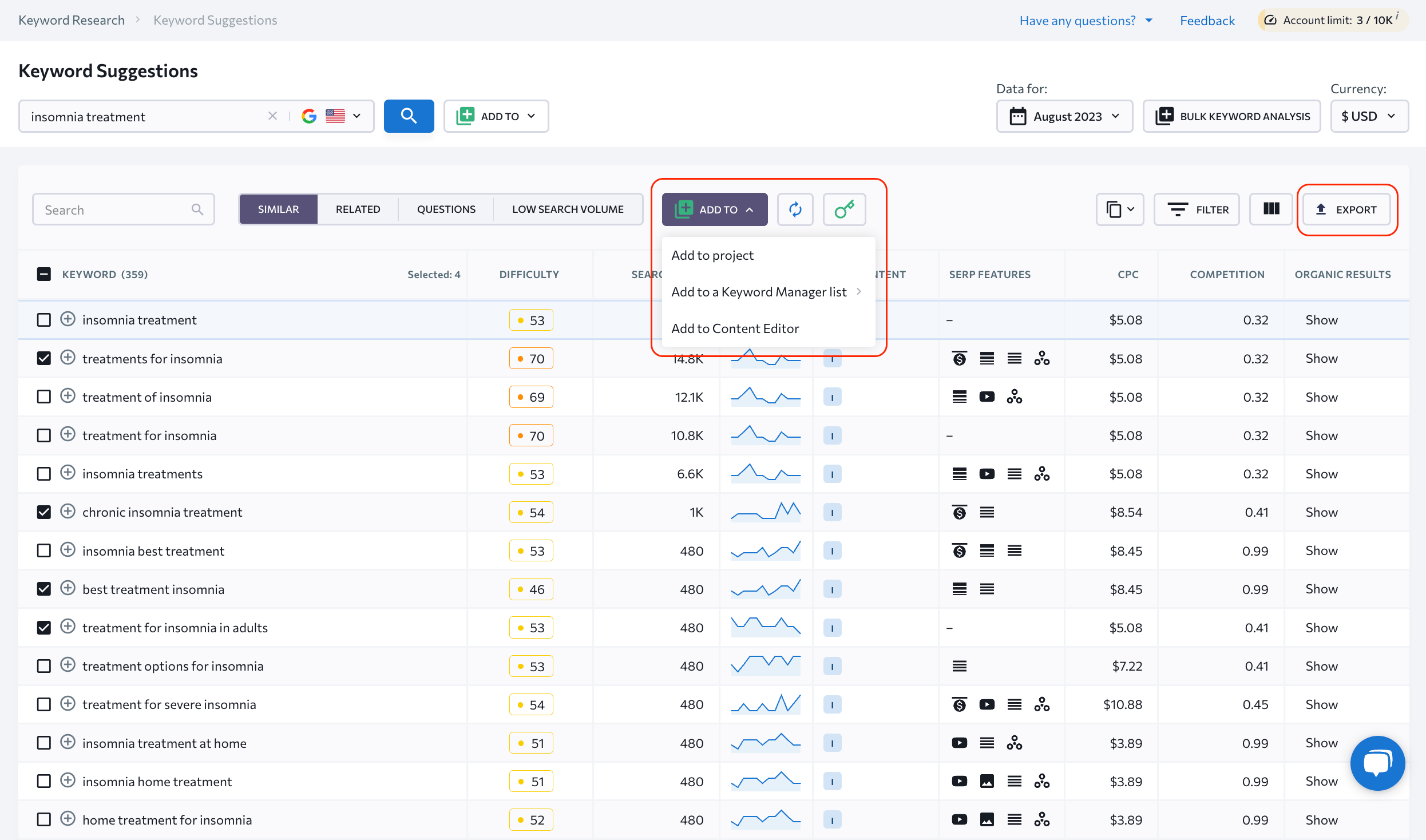
Organize keywords into keyword clusters to streamline your content creation process and improve your optimization efforts overall. A keyword cluster is a group of semantically related keywords. By grouping keywords together, you can plan your website structure (categories—subcategories—topics) and distribute keywords across the website more systematically. This makes it easier to tailor each page to a particular group and avoid cannibalization issues.
Prioritizing top-performing queries from Google Search Console
You can also use Google Search Console to identify keywords that get the most impressions and clicks. This means that Google finds your site highly relevant for these keywords. Go to the Queries section in the Performance report to find a list of such keywords. Then, make sure your pages are well-optimized for these keywords to get even more clicks and impressions.

Alternatively, you can sync your GSC account with SE Ranking. This will enable you to see clicks and impressions data alongside the accurate ranking data provided by our Keyword Position tool. As long as you add all your target keywords to your SE Ranking project, seeing a keyword flagged as “not tracked” signals that it requires extra attention.
Also, if “Not tracked” appears, then you probably haven’t optimized any of your pages for this keyword before.
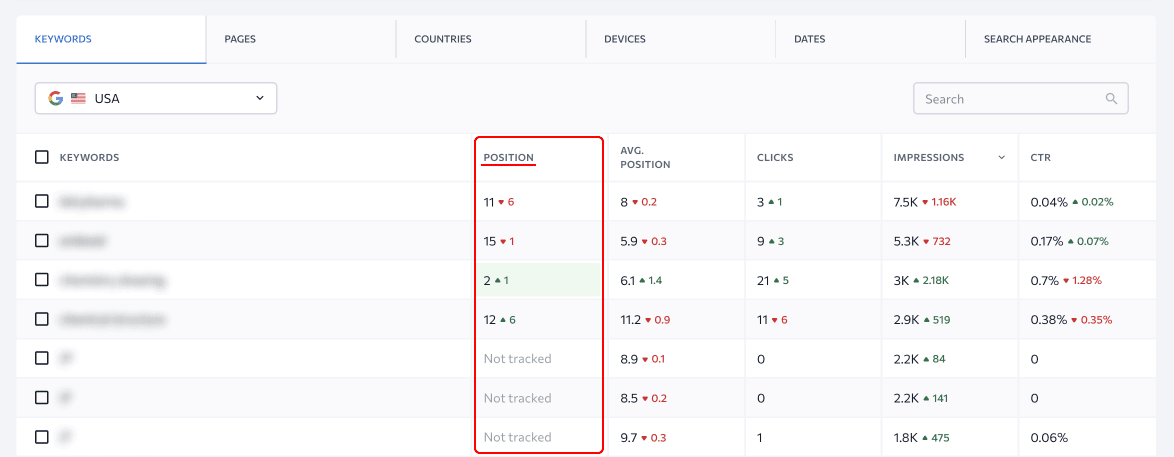
In the Keyword Position tool, you’ll immediately see which page is associated with each keyword and its level of optimization for that particular keyword—more about this in the next section.
Analyzing keyword optimization on a page
The next step is to audit your page elements and content for SEO. This is to see how optimized your pages are for your target keywords. There are many tools available to help you with this task.
Thanks to the integrated Content Score metric, users who track their target keyword positions with SE Ranking can easily spot pages that need to be optimized. Content Score is one of SE Ranking’s proprietary metrics. It measures how well a page is optimized compared to other top-ranking pages that target the same keyword. The content length, structure, keyword placement within the text, and keyword density all affect the score. If a keyword does not rank well, and the Content Score is not within the “green zone,” click the Improve score button to go to SE Ranking’s Content Editor and get improvement tips.

The Content Editor will then analyze the top-performing content on the SERP and give you real-time feedback, helping you to improve your keyword integration and content structure. You can follow the default recommendations or customize them:
- Choose which competitors’ metrics to take into account when assessing your content quality. By default, only competitors with below-average Content Score are disabled.
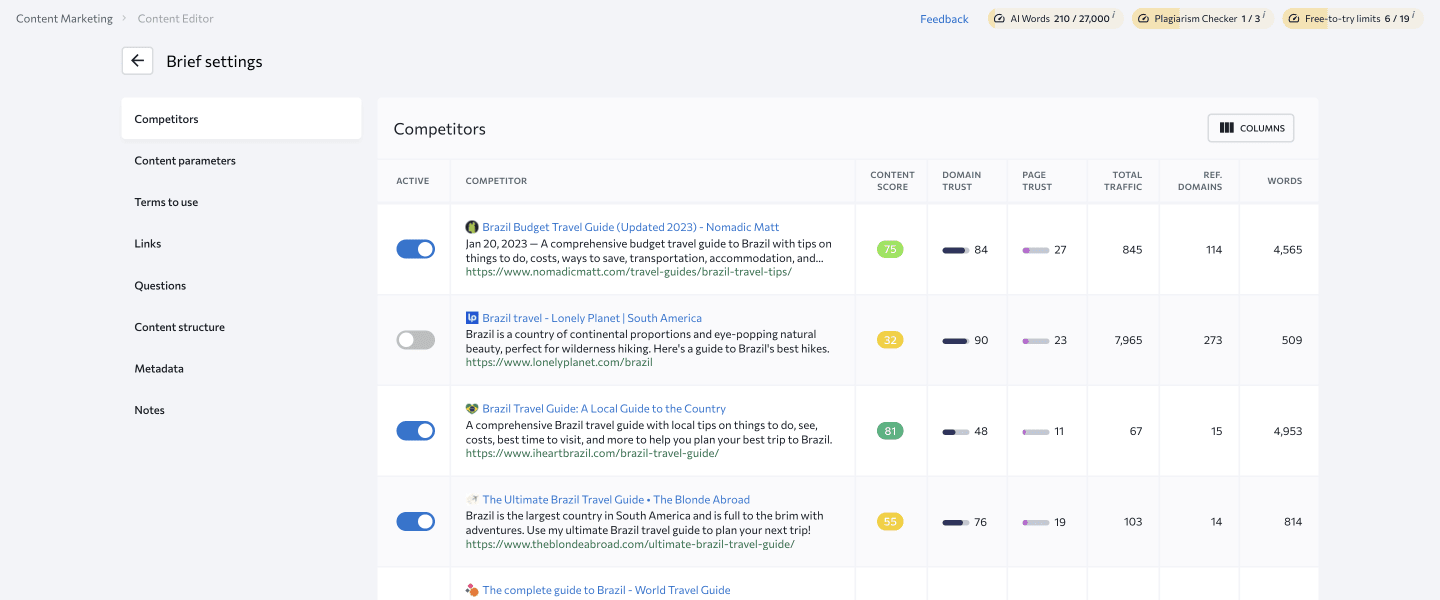
- Tick the keywords you want to feature in your article. All the suggested keywords are extracted with the help of the NLP model. Search engines will associate these words with your chosen topic and expect to see them in your content. By incorporating these keywords (or subtopics), you should be able to better meet user intent.
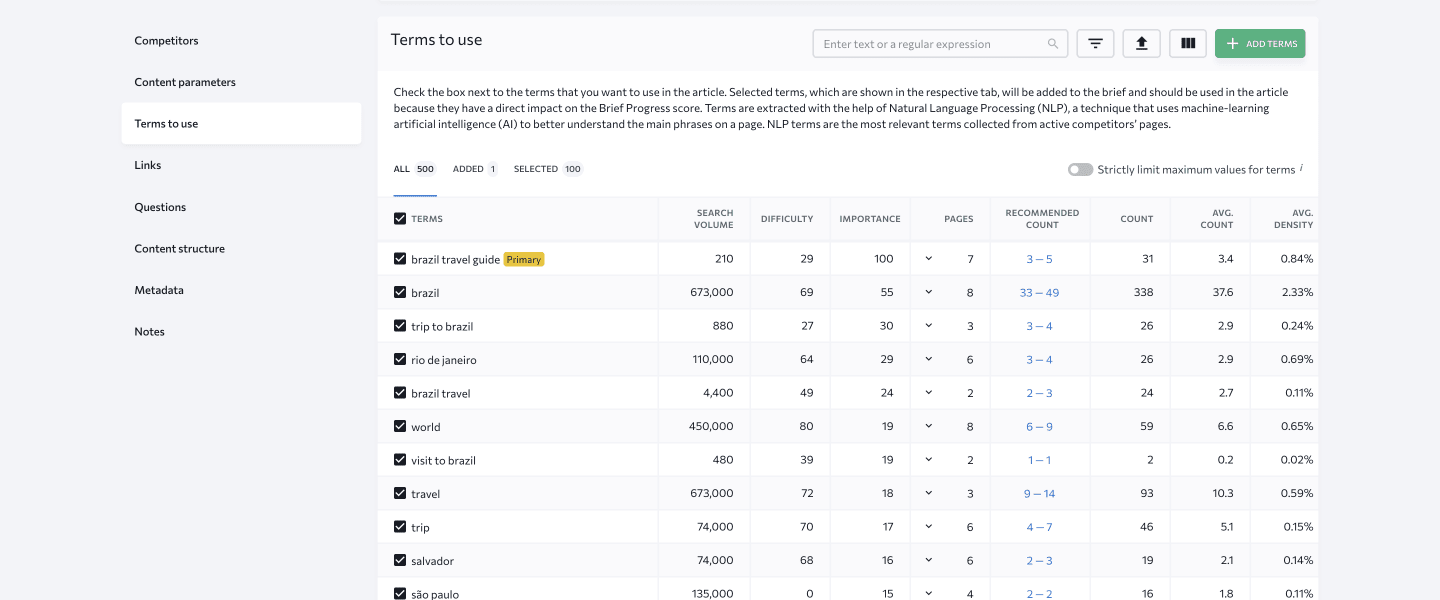
To see your page’s Content Score and the factors that affect it, hit the Go to Content Editor button. Next to your Content Score, you’ll see the average and maximum values in your target SERP.
Strive for the latter.

- In the Brief Progress section of the Optimization tab, you’ll see color-coded recommendations for the number of words, headings, paragraphs, images and terms in your content.
- In the Terms section, you’ll get a complete list of essential keywords for your content according to the set requirements. You’ll know how many of them are already used and which ones should be incorporated into your text. The tool also advises whenever a term needs to be added to a heading, highlighted in bold, etc.
To level up your on-page optimization efforts even further, consider using SE Ranking’s On-Page SEO Analyzer. Just like Content Editor, the On-Page SEO Analyzer assesses your content and provides recommendations based on an in-depth AI analysis of the top-ranking pages. At the same time, the on-page score is affected by many more factors, including title and meta description optimization, internal and external links, image alt tags, page experience metrics, and more.
To start the analysis, enter your URL, primary and secondary keywords, and define the target location and language. Once an audit has been completed, you will see the page score.
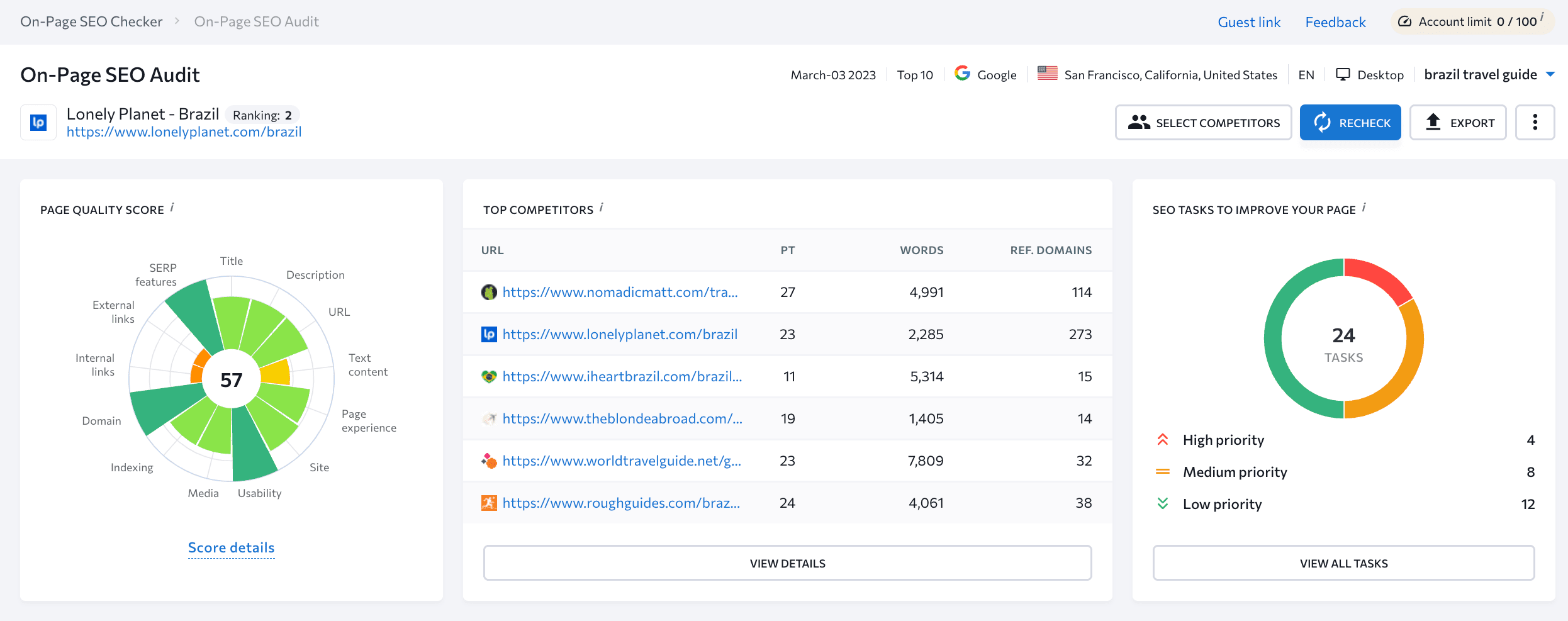
By scrolling down the On-Page SEO Audit page, you will see a detailed report that contains all the issues found on the analyzed page. It will be divided into errors, warnings, notices, and passed checks. Focus on these sections:
- Title and description: See if the page’s title and meta description include primary keywords and are close in length to the top-ranking pages.
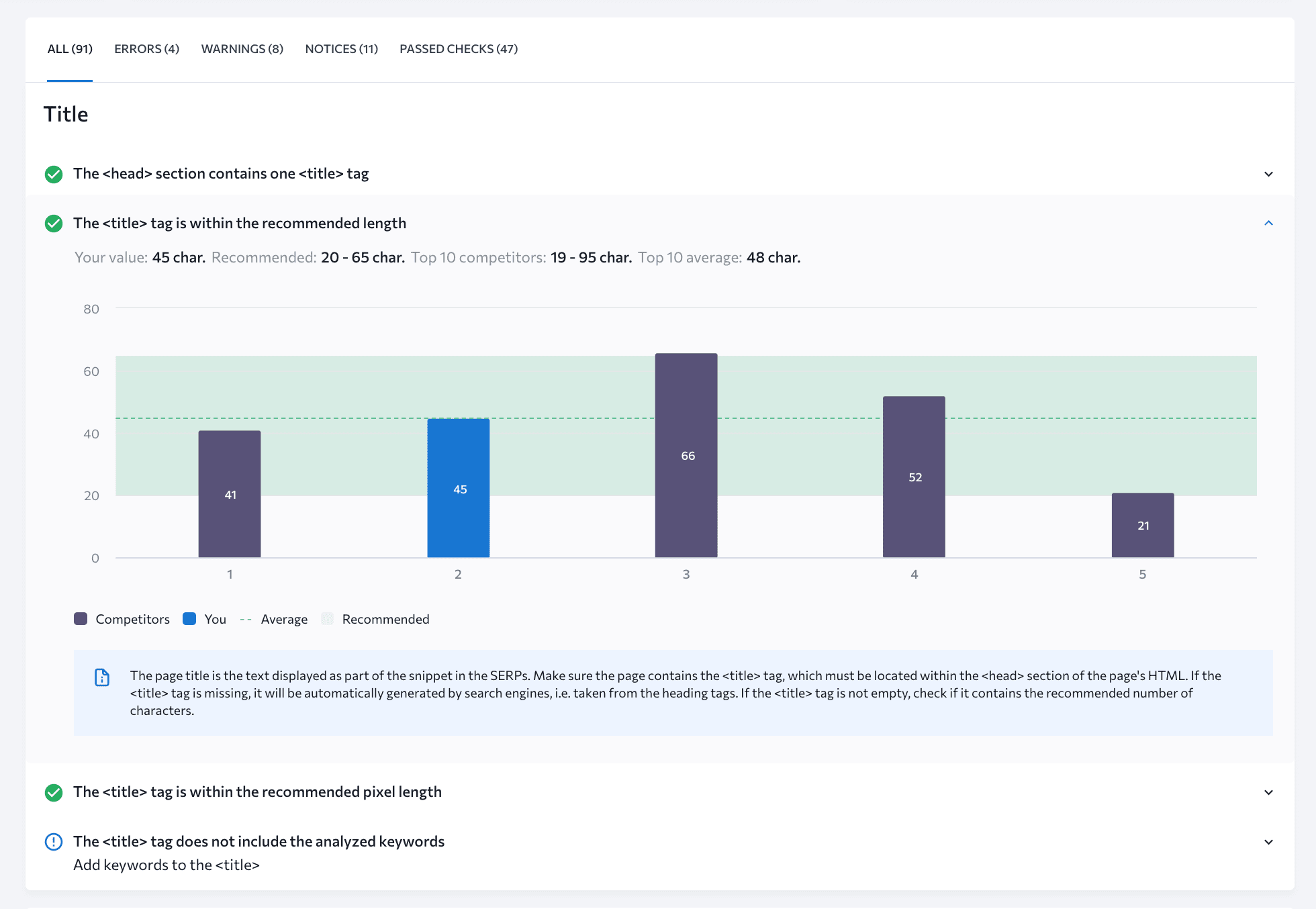
- URL: The tool shows if your URL includes the target keyword.
- Media: Your images should be properly optimized with alt text and title tags, and also contain proper filenames. They should be compressed to avoid slowing down loading times.
- Internal and external links: Consider their number and avoid linking to error or redirected pages.
- Page Experience: This has nothing to do with keyword optimization, but poor page experience can impede all your on-page optimization efforts.
Evaluating your content with the help of Content Editor and the On-Page SEO Checker might seem a bit daunting at first, but it should only take about 20-30 minutes. Fixing all the detected issues is a different story, but if you choose the right pages to focus on, it’s definitely worth the effort.
Optimizing your content for target keywords
Now that you’ve identified the top-priority keywords and analyzed the pages associated with them, it’s time to get to the brass tacks. Optimize each page element discussed above, see your Content and On-Page scores rise, and witness your rankings soar.
Here’s how you can automate the process using the SE Ranking’s tools:
- Optimize titles and descriptions based on the On-Page SEO Checker recommendations. Rely on what works in your target SERP. If you’re not much of a writer, go to the Metadata tab in Content Editor. In the right bar, you’ll see competitors’ titles and descriptions—you can use these for inspiration. You can also use our built-in AI writer to generate your title and description tags.
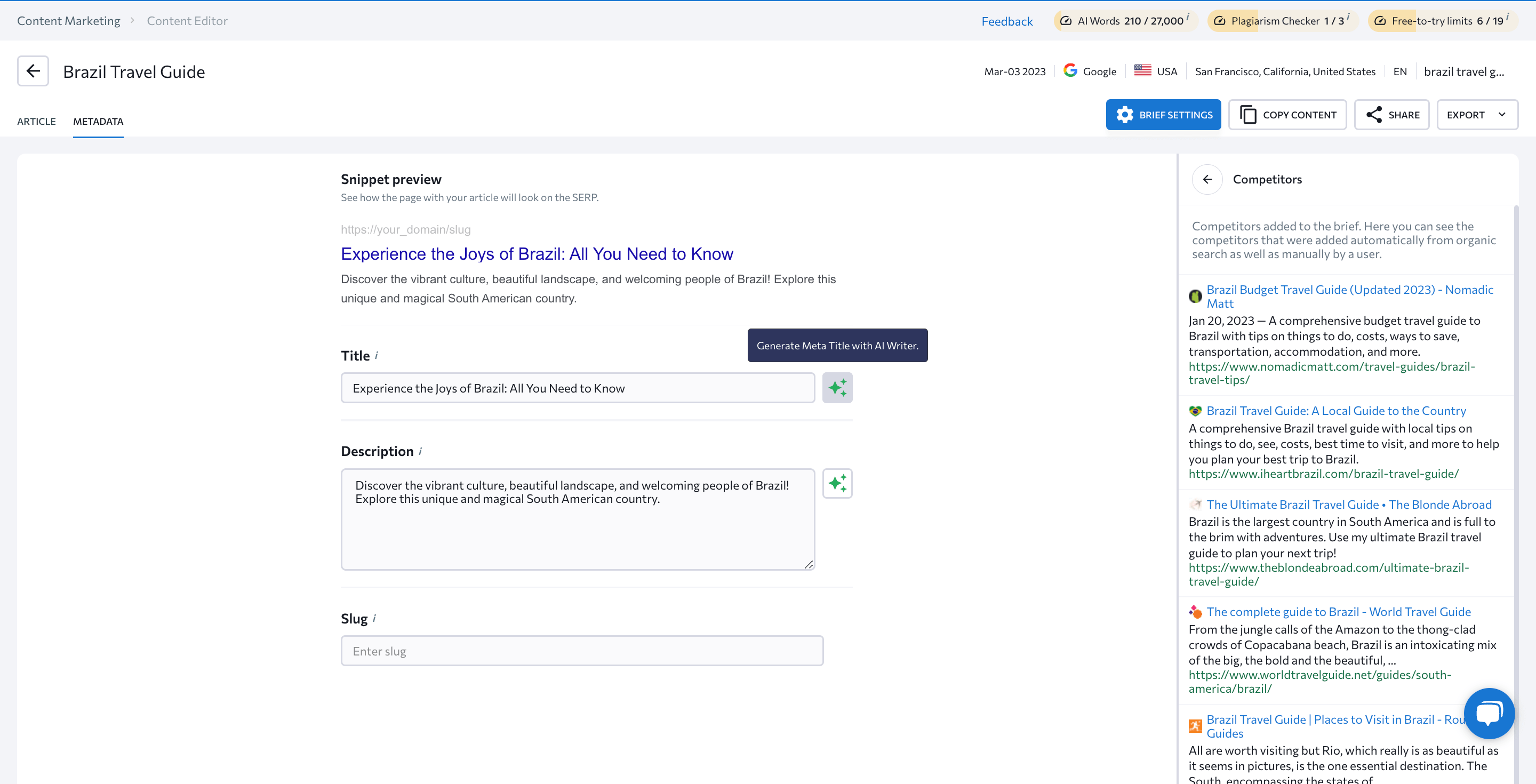
- Include target keywords in URLs: Having a keyword in your URL is an oft used and effective technique. Instead of using generic or numeric URLs, you should make them informative and user-friendly. Mind that changing the URL of an already existing page can lead to a temporary ranking drop and requires setting up a redirect. You’ll also need to update both the links to that page and their referring domains, so only change your URL if necessary.
- Strategically add keywords to your main content: Incorporate relevant keywords naturally throughout your content, ensuring they blend seamlessly into its context. Follow the Content Editor’s tips on the ideal frequency for each keyword, but prioritize your critical thinking. Aim for a natural and balanced keyword density and avoid keyword stuffing, which can negatively impact user experience and search engine rankings.
- Structure your content and optimize it for search intent: Maintain heading hierarchy (H1, H2, etc.), and make sure you cover all aspects of the topic that matter to your target users. It can be super useful here to review your competitor’s content structure. You can also automate this process with the Content Editor. All your competitor’s headings are featured in their respective section of the Brief settings. You can add any headings you want to include in your content to My headings. After that, you can paste them into your content.
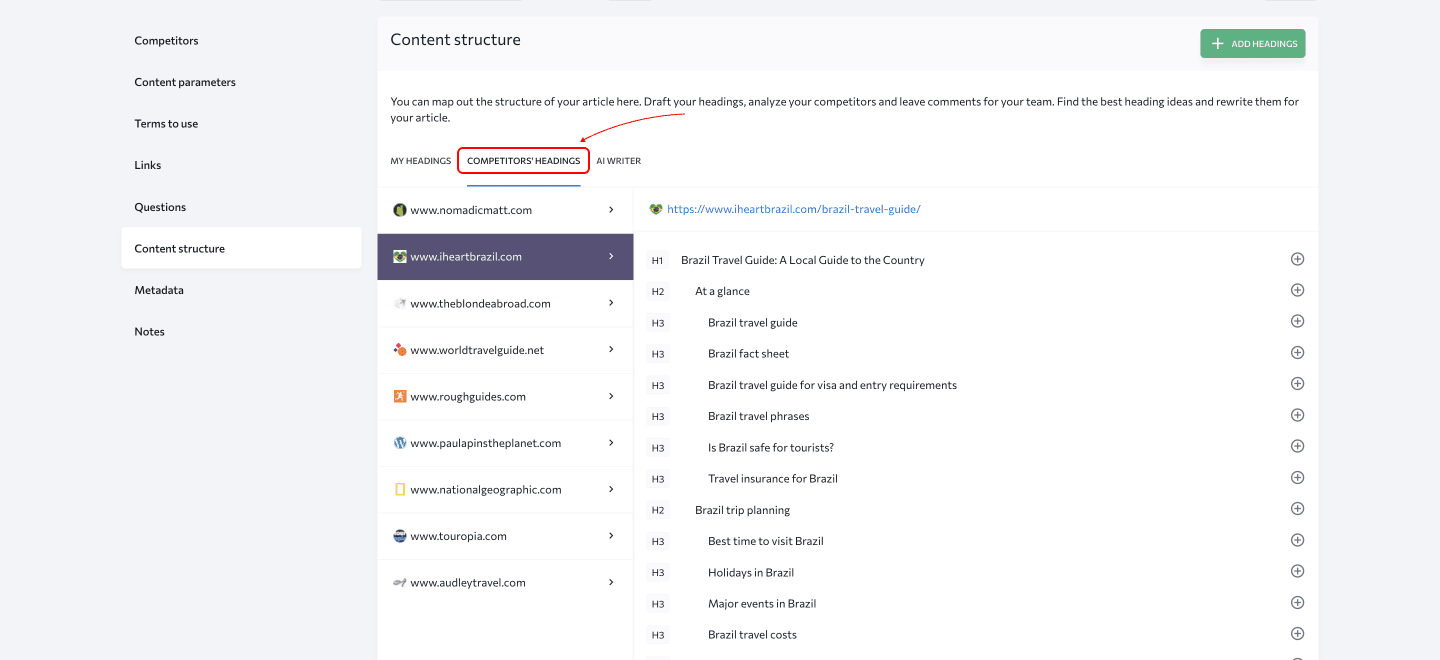
You may need to work with a professional writer to optimize your content. SE Ranking allows you to share tool access seamlessly with team members and contractors, even if they don’t have an SE Ranking account. You can either use the guest link option by clicking the Share button above the right-side panel, or move your article to Google Docs using the SE Ranking add-on.
- Optimize image filenames, titles, and alt tags: The On-Page SEO Checker will flag all the affected files for you. You can export the list of URLs to an XLS file. Check if your CMS offers plugins that let you edit alt tags in bulk.
- Enrich your content with internal and external links. Arm yourself with On-Page SEO Checker’s recommendations on the optimum number of links. Then link out to all relevant pages on your site. Keep these links as dofollow unless there is a clear reason for the opposite. Also, link out to authoritative external sources. Use the Link section of the Content Editor’s Brief Setup to see your competitors’ linking strategies for inspiration. You can use your target keywords as anchor texts when appropriate, but only if they fit naturally. Prioritize user experience and make sure your anchor texts are, first and foremost, informative.
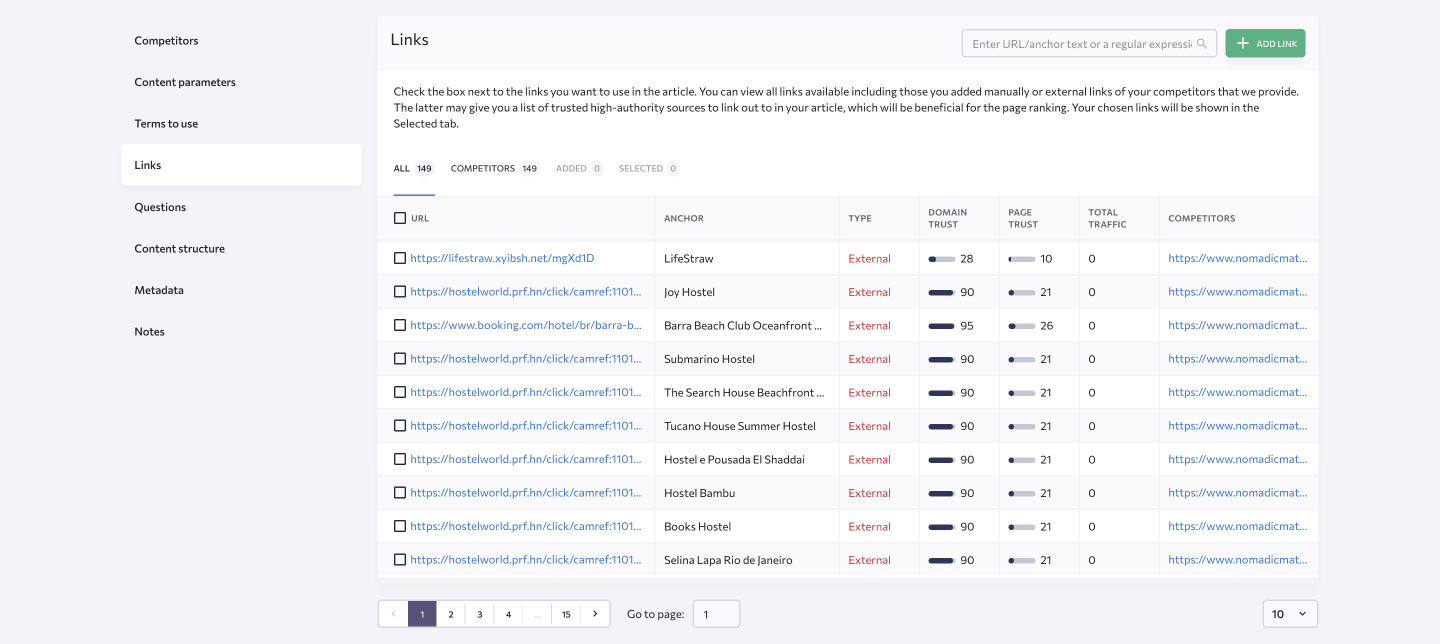
- Don’t underestimate the importance of Page Experience: This is one of the major ranking factors, meaning that having a low page experience score can stop you from reaching the top. Export all the issues detected by On-Page SEO Checker and contact the dev team to fix these issues ASAP, especially the critical ones. Ensure your on-page optimization extends to mobile devices. It should include mobile-focused and location-based keywords.
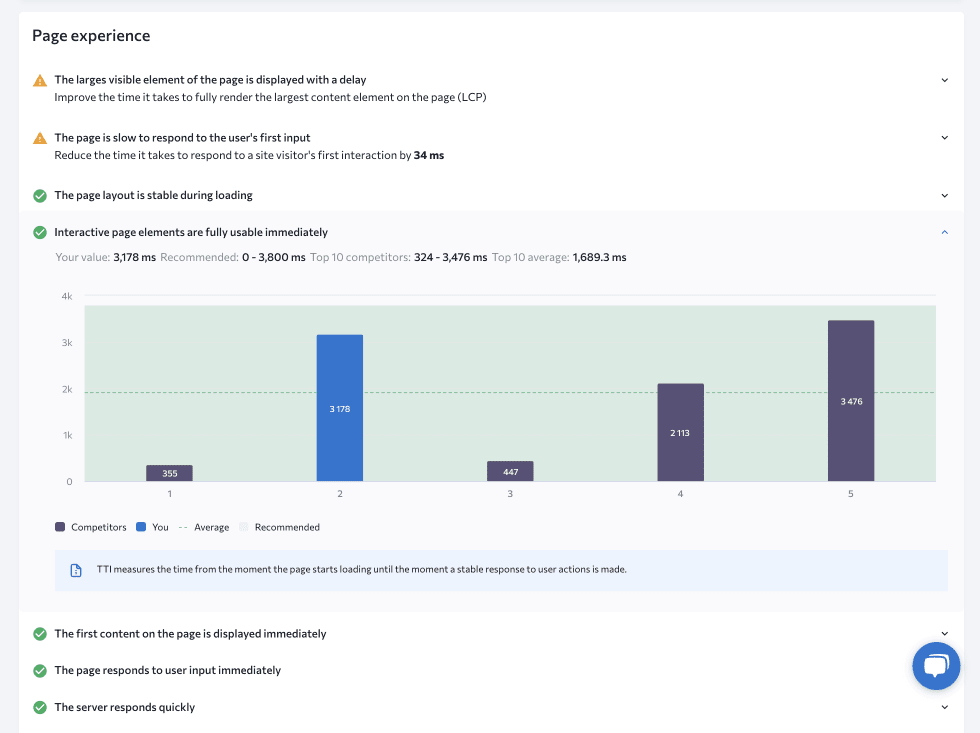
Remember, the ultimate goal of on-page keyword optimization is to create user-focused content that is relevant to search queries. Optimize content, tailor it to your readers, and use keywords they are likely to search for. This will improve your website’s visibility, increase organic traffic, and deliver a seamless user experience. Search engines will notice your commitment and reward you with higher rankings.
Also, track your progress by using SE Ranking’s Keyword Position Tool, which shows accurate keyword ranking positions for target keywords. Always compare your rankings before and after your optimization to assess the effectiveness of your efforts. Adjust your strategy accordingly.
Conclusion
Keyword optimization is an ongoing process. By understanding the basics of keyword optimization and applying them to your content marketing strategies, you can improve your website’s visibility in search results and attract more visitors.
Use specialized SEO tools to streamline the process of keyword research and on-page SEO analysis. Look for relevant keywords with appropriate search volume and competition, and incorporate them naturally into your pages. You also need to monitor your results and make adjustments as needed.
Now, it’s time to take action! Follow these tips to improve your website’s visibility in search results and attract more visitors. Good luck on your journey to keyword optimization excellence!
